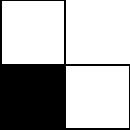NWERC11D - Piece it together
Tom has developed a special kind of puzzle: it involves a whole bunch of identical puzzle pieces. The pieces have the shape of three adjoint squares in an L-shape. The corner square is black, the two adjacent squares are white.

Figure 1: A puzzle piece
The puzzler is given a pattern of black and white squares in a rectangular grid. The challenge is to create that pattern using these pieces. The pieces can be rotated, but must not overlap.
Tom has already designed a few nice patterns, but he needs to find out if they can be constructed with the pieces at all. Rather than trying to test this for each pattern by hand, he wants to write a computer program to determine this for him. Can you help him?
Input
On the first line a positive integer: the number of test cases, at most 100. After that per test case:
- One line with two integers n and m (1 ≤ n, m ≤ 500): the height and width of the grid containing the pattern, respectively.
- n lines, each containing m characters, denoting the grid. Each character is ‘B’, ‘W’, or ‘.’, indicating a black, white or empty square respectively.
The grid contains at least one black or white square.
Output
Per test case:
- One line with either “YES” or “NO”, indicating whether or not it is possible to construct the pattern with the puzzle pieces. You may assume that there is an infinite supply of pieces.
Sample
Input: 2 3 4 BWW. WWBW ..WB 3 3 W.. BW. WBW Output: YES NO
Copyright notice
This problem text is copyright by the NWERC 2011 jury. It is licensed under the Creative Commons Attribution-Share Alike license version 3.0; The complete license text can be found at: http://creativecommons.org/licenses/by-sa/3.0/legalcode
| Added by: | Jeroen Bransen |
| Date: | 2011-11-02 |
| Time limit: | 4.868s |
| Source limit: | 50000B |
| Memory limit: | 1536MB |
| Cluster: | Cube (Intel G860) |
| Languages: | All except: ASM64 |
| Resource: | NWERC 2011 Jury |

 RSS
RSS